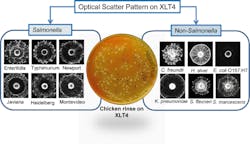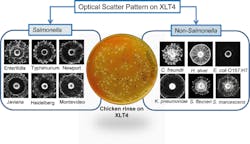Red diode laser device speeds Salmonella detection in food
Purdue University (West Lafayette, IN) researchers have developed a laser sensor device that can identify Salmonella bacteria grown from food samples about three times faster than conventional detection methods.
Related: IR spectroscopy speeds E. coli detection
Related: Laser technique modifies surfaces to prevent the spread of bacteria
The device, which they call "bacterial rapid detection using optical scatter technology," or BARDOT, uses a red diode laser to scan bacteria colonies on an agar plate. When the light penetrates a colony, it produces a scatter pattern, a unique arrangement of rings and spokes that resembles the iris of an eye. The pattern is matched against a library of images to identify the type of bacteria. What's more, it takes less than 24 hours to pinpoint Salmonella.
Current Salmonella detection methods can take 72 hours to yield results and often require artificial alteration of the bacteria colonies. But the BARDOT system identifies bacteria colonies by using light to illuminate their natural characteristics, preserving the colonies for later study. The machine can be operated with minimal training and used in locations with limited resources, says Arun Bhunia, a professor of food science who collaborated with then-Purdue engineer Daniel Hirleman to create the machine.
To test BARDOT's ability to identify Salmonella, Bhunia and his fellow researchers grew bacteria from rinses of contaminated chicken, spinach, and peanut butter on agar plates for about 16 hours. After the plates were covered with tiny spherical colonies of bacteria, they placed each plate inside BARDOT—which is about the size of a large microwave oven—and scanned the colonies.
BARDOT identified Salmonella bacteria with 95.9 percent accuracy. It also individually distinguished eight of the most prevalent Salmonella serovars (distinct variations within a species of bacteria). Identifying a particular serovar helps trace bacteria to the original source of contamination.
Atul Singh, postdoctoral research associate and first author of the study, says that BARDOT could be an effective preliminary screening tool, especially for food processors testing a large number of samples. And while many tools can only detect a single kind of bacteria, BARDOT picks out multiple types of disease-causing bacteria on a plate with a single scan, Bhunia says. In addition to Salmonella, BARDOT can identify E.coli, Vibrio, Listeria, Bacillus, and many more foodborne pathogens.
Full details of the research team's work appear in the journal mBio; for more information, please visit http://mbio.asm.org/content/5/1/e01019-13.
-----
Follow us on Twitter, 'like' us on Facebook, and join our group on LinkedIn
Subscribe now to BioOptics World magazine; it's free!

